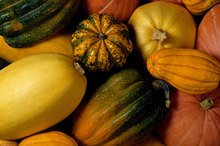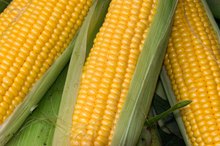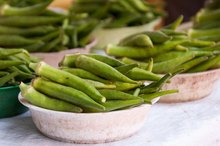What does fact checked mean?
At Healthfully, we strive to deliver objective content that is accurate and up-to-date. Our team periodically reviews articles in order to ensure content quality. The sources cited below consist of evidence from peer-reviewed journals, prominent medical organizations, academic associations, and government data.
- MayoClinic.com: Exchange List: Starches
- PubMed.gov: The Starch and Total Sugar Content of Mexican Fruit and Vegetables
- PubMed.gov: The Starch and Total Sugar Content of Mexican Fruit and Vegetables
The information contained on this site is for informational purposes only, and should not be used as a substitute for the advice of a professional health care provider. Please check with the appropriate physician regarding health questions and concerns. Although we strive to deliver accurate and up-to-date information, no guarantee to that effect is made.
Plants store glucose in the form of starch, which is a polysaccharide. Polysaccharides are used by the body for structural support and as a source of energy, according to Elmhurst College’s Virtual Chembook 1. Your body begins to digest starch as soon as it enters your mouth, via salivary enzymes that break it into smaller molecules. Further along the digestive tract, pancreatic juices and enzymes found in the lining of the small intestine break down starches first into maltose and then into glucose. A number of fruits and vegetables are high in starch 5.
Potatoes
All kinds of potatoes, including sweet potatoes, are high in starch, according to the University of Michigan Health System. These foods are typically low on the glycemic index, which makes them good choices for people who are trying to manage their blood-sugar levels. According to MayoClinic.com, one quarter of a large baked potato with the skin on equals one exchange serving, as does 1/2 cup of yam or sweet potato served plain 3.
Squash
Japanese Sweet Potato Nutrition
Learn More
Squash, the plant group that includes acorn, butternut squash and pumpkins, are conventionally thought of as vegetables, though botanically speaking, they’re actually fruit.include:
- Squash
- the plant group that includes acorn
- butternut squash
- pumpkins
- are conventionally thought of as vegetables
- though botanically speaking
- they’re actually fruit
Pumpkins are low in calories, rich in potassium and loaded with beta-carotene, an important free-radical-fighting antioxidant. A cup of canned pumpkin provides one exchange serving, for those following a diabetic diet. A cup of either acorn or butternut squash is also equal to one exchange.
Corn
Corn, whether it’s on the cob or ground up to form corn meal, is a rich source of starch. The University of Michigan Health System states that starchy vegetables such as corn are metabolized slower than simple sugars and more like a grain. They contain fiber, nutrients and phytochemicals and provide the brain and the nervous system with energy. Polenta, a corn-meal mush, can be prepared to serve as the central starch in a meal. Corn is gluten-free, thus can be tolerated by those with celiac disease, also known as gluten intolerance.
- Corn, whether it’s on the cob or ground up to form corn meal, is a rich source of starch.
- Polenta, a corn-meal mush, can be prepared to serve as the central starch in a meal.
Plantain
Do Green Field Peas Count as Vegetable or Starch in Diabetic Diet?
Learn More
Most foods that are traditionally thought of as fruit are not typically high in starch, but plantain is an exception. This banana-like staple of Mexican cuisine contains about 45 g of carbohydrate per cup and was found have the highest concentration of starch in a study comparing various Mexican fruits and vegetables, according to Castillo Sanchez of the Salvador Zubiran National Institute of Nutrition in Mexico 5.
Related Articles
References
- Elmhurst College Virtual Chembook: Starch
- American Diabetes Association: Carbohydrates
- MayoClinic.com: Exchange List: Starches
- Diet Bio: Pumpkin Cucurbita Maxima
- PubMed.gov: The Starch and Total Sugar Content of Mexican Fruit and Vegetables
- Al-Mana, N. M., & Robertson, M. D. (2018). Acute Effect of Resistant Starch on Food Intake, Appetite and Satiety in Overweight/Obese Males. Nutrients, 10(12), 1993. doi:10.3390/nu10121993
- Bindels, L. B., Segura Munoz, R. R., Gomes-Neto, J. C., Mutemberezi, V., Martínez, I., Salazar, N., … Ramer-Tait, A. E. (2017). Resistant starch can improve insulin sensitivity independently of the gut microbiota. Microbiome, 5(1), 12. doi:10.1186/s40168-017-0230-5
- Canani, R. B., Costanzo, M. D., Leone, L., Pedata, M., Meli, R., & Calignano, A. (2011). Potential beneficial effects of butyrate in intestinal and extraintestinal diseases. World journal of gastroenterology, 17(12), 1519–1528. doi:10.3748/wjg.v17.i12.1519
- Haub, M. D., Hubach, K. L., Al-Tamimi, E. K., Ornelas, S., & Seib, P. A. (2010). Different types of resistant starch elicit different glucose reponses in humans. Journal of nutrition and metabolism, 2010, 230501. doi:10.1155/2010/230501
- Brighenti, Furio et al. " Colonic fermentation of indigestible carbohydrates contributes to the second-meal effect." American Journal of Clinical Nutrition 83.4 (2006): 817-822.
- Cummings, JH. "The Large Intestine in Nutrition and Disease: (monograph), December 1996, ISBN 2-930151-02-1.
- Englyst, Klaus, et al. "Glycaemic index of cereal products explained by their content of rapidly and slowly available glucose." British Journal of Nutrition. 89 (2003):329-339.
- Englyst, Klaus and Englyst, Hans. "Carbohydrate Bioavailability." British Journal of Nutrition 94 (2005): 1-11.
- Higgins, Janine, et al. "Resistant starch consumption promotes lipid oxidation." Nutrition and Metabolism 1.8 (2004): 1743-7075.
- Higgins, Janine. "Resistant Starch: Metabolic Effects and Potential Health Benefits." Journal of AOAC International 87 (2004):761-8.
- Robertson, M.D. et al. "Prior Short-Term Consumption of Resistant Starch Enhances Postprandial Insulin Sensitivity in Healthy Subjects." Diabetologia 46 (2003): 659-665.
Writer Bio
For 15 years, Charis Grey's award-winning work has appeared in film, television, newspapers, magazines and on the Internet. She has worked as a story editor on the CBS drama "Flashpoint" and her work appears bimonthly in "The Driver Magazine." She has a Bachelor of Science in biology and a doctorate in chiropractic medicine from Palmer College.









